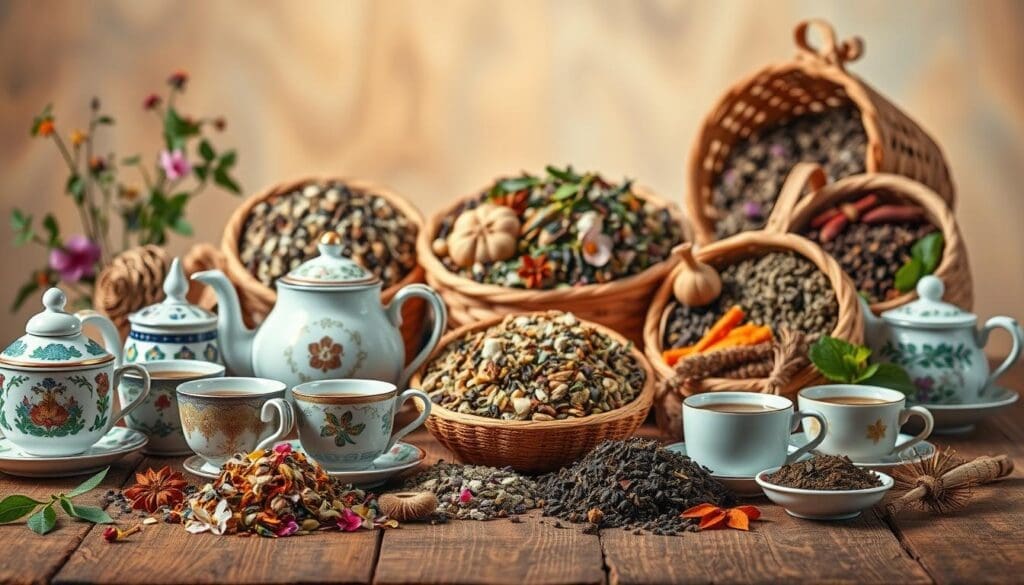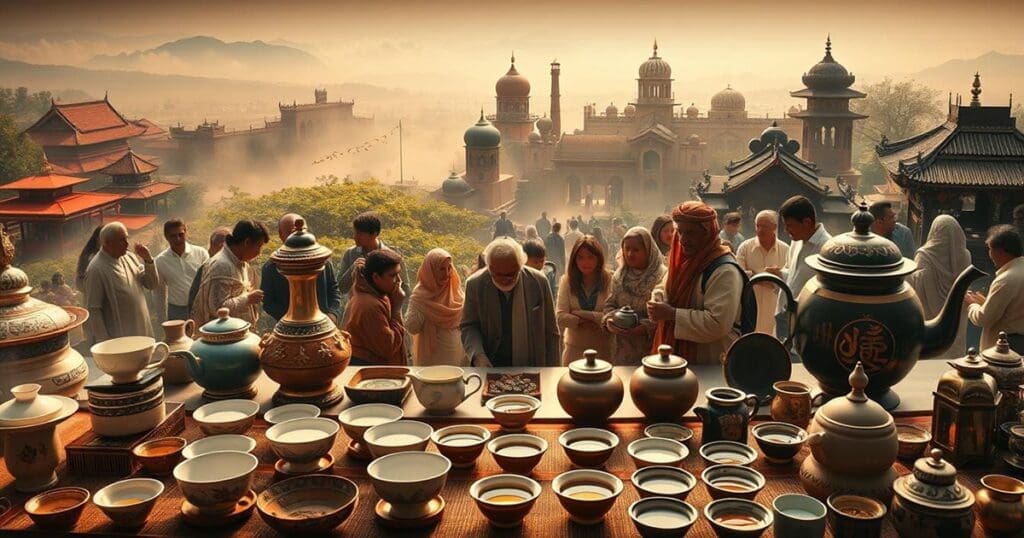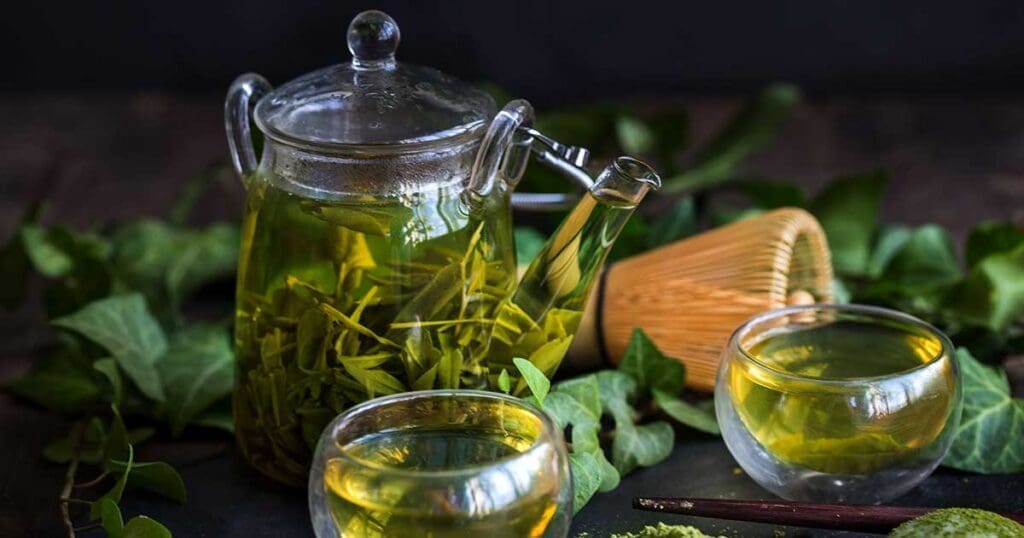Tea is loved worldwide, with its cultural role changing from place to place. It’s a key part of many societies, showing its deep importance. Tea traditions and customs vary, from tea ceremonies to chai, bringing people together.
Tea’s history and cultural value are huge in countries like India, China, and Japan. It’s more than a drink; it’s a way of life. Tea traditions and customs show its vital role in these cultures, shaping their tea culture.
Introduction to Tea and Its Cultural Significance
Tea has been a key part of many cultures for centuries. Its unique flavor and aroma make it a favorite in many places. Tea is seen as a symbol of hospitality, respect, and community worldwide.
In countries like China, tea is more than just a drink. It’s a way to connect, discuss business, and even solve conflicts. The tea traditions in China are filled with history and rules. For example, the youngest or lowest person always serves the first cup to the oldest or highest.
In Japan, the traditional tea ceremony is all about mindfulness and respect. It shows the deep importance of tea rituals in Japanese culture.
Tea’s cultural value isn’t just in East Asia. Global tea customs have grown through trade, migration, and cultural exchange. Tea has become a big part of many cultures, from the British in India and Ceylon to the Dutch in Europe.
Learning about tea traditions and tea rituals in different cultures can give us a peek into their history, values, and customs.
Tea in East Asian Cultures
East Asian cultures have a rich history of cross-cultural tea practices. Each country has its own tea customs and traditions. From the delicate Chinese tea sets to the vibrant Japanese matcha bowls, tea has shaped cultural diversity in tea consumption. In China, tea drinking became prominent during the Tang dynasty, marking its cultural significance.
In Japan, tea consumption trends have been influenced by the country’s history and traditions. The Japanese tea ceremony, known as chanoyu, involves precise steps in tea preparation. It is often conducted in a designated tearoom. This tradition reflects the cultural diversity in tea consumption and the importance of tea in Japanese culture.

In Korea, tea is an integral part of hospitality. Traditional tea ceremonies known as Darye are practiced today. The cross-cultural tea practices in Korea have been influenced by Chinese and Japanese traditions. This has resulted in a unique blend of tea customs and rituals.
Tea Traditions in the Middle East
The Middle East boasts a rich tea culture, with each country having its own special tea traditions. In Morocco, tea is a key part of welcoming guests, with mint tea being a favorite. Tea is served in colorful glasses on silver trays, showing its importance.
In Iran, chai is a beloved drink with its own set of traditions. Making chai is an art, needing the perfect mix of spices and tea leaves. Tea is served in small cups with sweets and snacks, highlighting its cultural value.
The tea traditions in the Middle East go beyond just drinking tea. They are deeply rooted in social and cultural practices. Tea is a key part of social events and business meetings, showing respect and hospitality. Whether it’s Iran’s chai or Morocco’s mint tea, tea’s cultural importance is clear.
The Influence of British Tea Customs
Tea has been a big part of British culture for centuries. Tea rituals and tea ceremonies are key in social events. The British love tea so much, they drink a lot of it every year.
The British tea culture is all about sharing tea with everyone nearby. This tradition goes back to the 18th century. Adding sugar to tea became popular around the same time as sugar imports from the Americas.
In Britain, tea rituals are a big part of everyday life. Tea drinkers often have eight or more cups a day. There’s a big debate on whether to add milk first or last, but the right ratio is 80:20 tea to milk.
Tea parties in Britain are special, needing the best cups and treats. This shows how tea is loved and enjoyed worldwide. The British way of drinking tea has influenced many cultures, making tea a favorite drink everywhere.
Tea Practices in India
India is famous for its lively tea culture. A lot of people drink tea every day. It’s the second-biggest tea maker in the world, with a long history of tea.
The cultural significance of tea in India is clear in its tea ceremonies and social events. Tea is key in these gatherings.
India’s tea traditions vary by region, with each having its own tea-making ways and tastes. Masala chai, a spiced tea, is loved by many. Tea plays a big role in Indian social and cultural events.
In India, tea is more than a drink; it’s a big part of the country’s heritage and identity. The tea industry in India has grown a lot, with many Indian tea brands known worldwide. The tea culture in India shows the country’s rich cultural diversity and its ability to change and grow.
The Emergence of Herbal Teas in Modern Cultures
As people focus more on wellness and healthy living, cross-cultural tea practices are changing. Herbal teas, made from plants, are caffeine-free. They can be single herbs or blends for health benefits. The demand for herbal teas is growing, thanks to their health perks, seen in tea consumption trends.
The cultural diversity in tea consumption shows in herbal teas. Different cultures use herbal teas in their own ways. For instance, peppermint tea is loved in the West for digestion, while chamomile is cherished in the East for calmness. Herbal teas are also sought for their eco-friendly nature.

Herbal teas are now a big part of modern tea culture. They offer unique tastes and health benefits, attracting many. As tea consumption trends keep changing, herbal teas will likely be key in the tea industry’s future.
The Cultural Significance of Tea in Africa
Africa’s tea culture is rich and varied. Each country has its own special cultural significance of tea and tea traditions. From Ethiopia’s coffee ceremonies to South Africa’s rooibos tea, every area has its own unique tea culture.
In many African countries, tea traditions are key in social events and welcoming guests. In Morocco, mint tea is a big part of their tea culture. In South Africa, rooibos tea is a favorite herbal drink. Tea’s cultural significance in Africa shows in how it’s made and enjoyed, often with big ceremonies.
The importance of tea culture in Africa goes beyond social and cultural aspects. It also plays a big role in the economy. Kenya, for example, is a top tea producer in Africa, exporting a lot to the UK. The tea traditions in Africa show the continent’s rich culture and its ability to change and grow.
The Role of Tea in Western Countries
Tea has become a big part of Western cultures. People love trying new and exotic teas. From bubble tea shops to tea festivals, tea is key in social events and gatherings. Tea rituals and tea ceremonies are now found in Western countries, showing the wide range of worldwide tea customs.
In the United States, bubble tea is very popular. Tea shops offer many flavors and toppings. Tea festivals and gatherings are also common, where people share their love for tea and learn about different cultures.

Tea is not just for social events in Western countries. It’s also a part of daily life. Many people drink tea for its health benefits, as a coffee substitute, or to relax in the evening.
The Symbolism of Tea Across Cultures
Tea is a big part of many cultures worldwide. It’s not just a drink; it’s about the experience and the company. In many places, tea shows respect and friendship, bringing people together.
The art of making tea is highly valued. From Chinese tea sets to Japanese tea ceremonies, each step is special. Every culture adds its own twist to the tea-drinking tradition.
Tea is more than a drink; it’s a way of life. It symbolizes hospitality, respect, and friendship in many cultures. Traditional tea ceremonies are key in social gatherings, showing the importance of tea.
In many cultures, tea is a big part of daily life. It’s not just about the tea but the experience and respect it brings. Tea’s rich history and cultural significance make it a beloved drink worldwide.
The Future of Tea in Cultural Practices
Looking ahead, tea will remain a key part of our cultural traditions. Tea trends are moving towards more eco-friendly and fair choices. The way tea is made and enjoyed varies greatly across cultures.
Innovations in Tea Experiences
The tea world is changing with new tea blends and hand-rolled leaves. People want tea that’s good for the planet and fair to farmers. Tea makers are now using eco-friendly methods like fair-trade and organic farming.
Sustainability and Ethical Tea Consumption
More people want tea that’s good for the environment. Companies are making tea packaging and production greener. This shift shows how tea can bring cultures together while caring for our planet.
Conclusion: Celebrating Tea as a Cultural Connector
As we wrap up our exploration of tea cultures and traditions, it’s clear that tea connects people worldwide. It bridges communities and brings a sense of unity. From East Asia’s tea ceremonies to the Middle East’s tea gatherings, tea culture is a big part of many societies.
The cultural significance of tea goes beyond just drinking it. It shows the rich histories, customs, and values passed down through generations. The tea traditions we’ve seen highlight the art, respect, and community that tea fosters. It’s a universal language that crosses borders and cultures.
The global tea market is growing fast, expected to hit over $300 billion by 2027. This means more people want real and deep tea experiences. Tea festivals, eco-friendly farming, and specialty teas show tea’s future role in shaping cultures and uniting people.




Facebook Comments